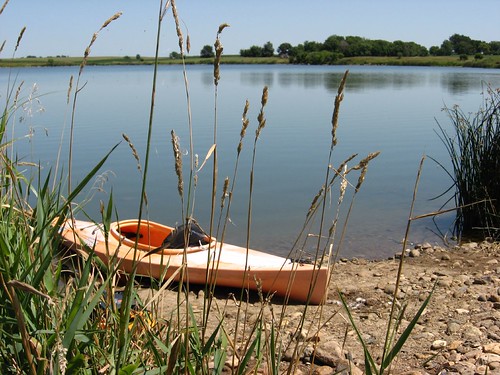
Part II: The Appropriate Boat for the Older Paddler
Over the past forty years, I have had a variety of boats. When I was in my 20s and 30s, I thought nothing of heaving a 17-foot aluminum canoe up onto a roof rack. But, I also had some back strains that would nearly incapacitate me for a couple of weeks. Big heavy canoes are also hard to paddle alone, and this sort of boat has seemed increasingly ill-suited for the older paddler. The development of Kevlar, however, has extended canoeing possibilities, and I feel that the much more expensive Kevlar boats are worth the extra cost, especially for the older paddler.

(solo canoe encountered on Lake Alvin)
Many years ago, I had a 15-foot solo canoe that was a great improvement over the heavy aluminum craft. Solo canoes are available in Kevlar and are light enough for most older paddlers to load and carry alone. I think that a solo canoe is a great choice for the older paddler; a principal reason for that observation is the issue of entering and exiting the boat. It is easier, I feel, to get into a canoe than a kayak, especially when using a paddle across the gunwales to provide support. The next boat that I purchase will probably be a Kevlar constructed solo canoe. I think that such a craft would serve me well at this point in life.
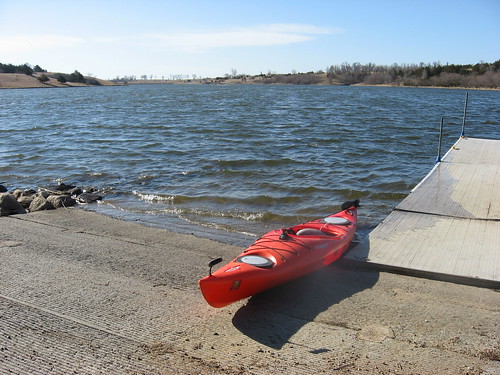
Presently, I have a 13-foot Dagger kayak that weighs about 55 pounds. I find that it is difficult to carry the kayak for more than 100 feet or so and have accumulated some equipment to help in that process. First of all, I carry a pair of heavy leather gloves to protect my hands from the edges of the cockpit when carrying the boat. I also have a wheeled cart that I can use to push the boat from the car to a launching site. In addition, I have a special strap that I can use when carrying the kayak to shift the weight from my arms to my back.
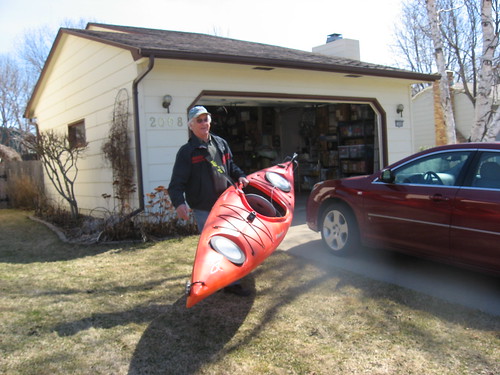
It is important to have a boat with watertight bulkheads to isolate the bow and stern compartments from the cockpit. In the event of a capsize, these watertight compartments will ensure that the boat will float, and it would be much easier to empty the hull of water. So I feel safer knowing that the boat will not sink and that it would provide another floatation device in the event of an upset.
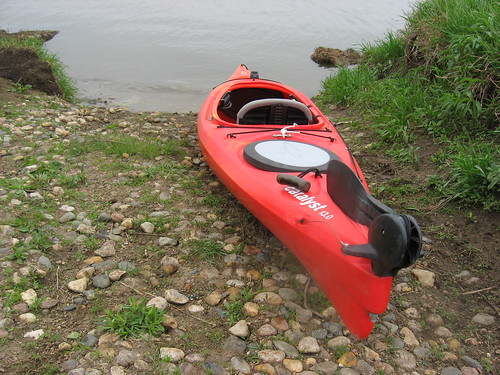
My boat also has a rudder that I use most of the time, although I think that it is probably a detriment on narrow creeks. The rudder reduces the need for corrective strokes while cruising and helps ensure good tracking and easier turning. As a photographer, it is also much easier for me to glide up upon my subject without concern about directional drift of the boat.
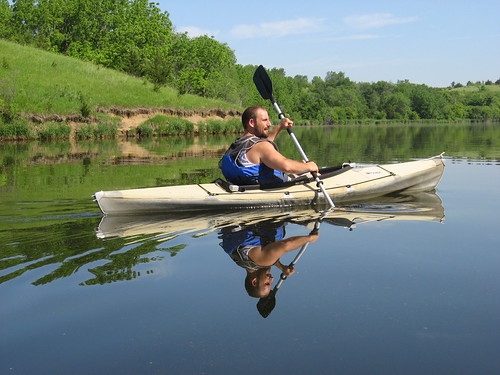
My second boat is a 12-foot Folbot Aleut, a collapsible fabric covered kayak that can fit into two bags. This type of boat is useful for anyone who is leery about transporting a kayak or canoe on a car roof rack or who has a storage problem. The boat bags can easily fit in the trunk of most cars, including my Honda Civic, or in the back seat. It can also be stored in the garage or even in a closet. This sort of boat is very stable and easy to maneuver and would serve the older paddler quite well. The only issue with a Folbot is the need to assemble it at the launch site. It takes me about 15 minutes to put the boat together; for a retiree, time ought not to be much of an issue. Still, putting it together in the hot sun is a drain for me, and I often think about how I would be off and cruising with my rigid kayak during the assembly time required. I alternate between enthusiasm for the Folbot and irritation with the assembly process. With the Folbot, there is no need for a roof rack or a dedicated storage rack for the kayak in the garage. So, if an older paddler is interested in scaling back on equipment and is considering less housing space, the Folbot is a good choice for the older paddler. The boats are quite dependable, stable, strong, and seem built to last many years. I have owned mine for over ten years, and it has shown no sign of serious wear over that time.

People use ingenious ways to transport their boat. Most use a roof rack, and that is my method as well. I use a Yakima rack with rollers and a kayak cradle. Since I want to be equipped to easily load my kayak alone, I adapted a process that I first observed used by the late Dick Davidson, one of the early canoe enthusiasts in the region, a legendary long distance trekker, and the long-time president of the South Dakota Canoe Association. I just bought an inexpensive mat that I can lay over the trunk and rear window of my car and use that surface to rest my kayak as I slide it over the rear of the car and up onto the roof rack. This technique allows me to easily load my kayak alone, and this is especially important for the older paddler. I would not want to be in a position where I had to always seek out help in lifting the kayak up into the roof rack.
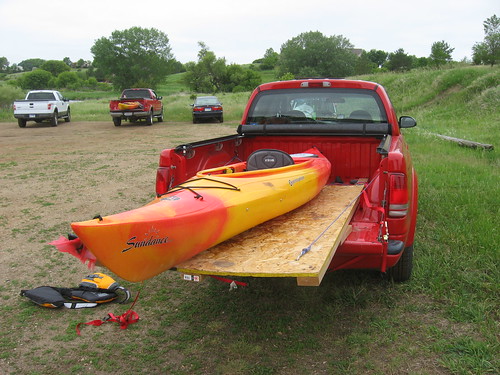
Some people use a pick-up truck with a plywood bed extension for the kayak. The boat can just be secured to the plywood and ride fairly easily in the bed of the truck. Some just toss the kayak in the bed of a pick-up, attached it with a few bungee cords, and “call it good.” A few people have kayak/canoe trailers, and a few people have a short kayak that can fit inside an SUV. For the older paddler, a trailer would be terrific, and there is a manufacturer in Hull, Iowa, with trailers for one, two, or multiple kayaks or canoes. Of course, the rub with having a trailer is finding a spot to park it at home. A lack of such space has deterred me from taking that step.
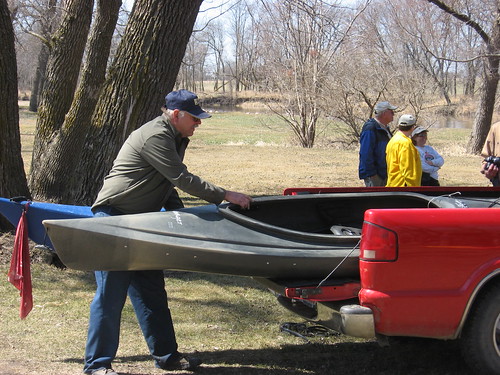
I have considered purchasing one of the shorter lightweight kayaks made of a plastic material. Such kayaks can weigh only 30 pounds or so, and it would be relatively easy to deal with loading and hauling a little nine-footer. Perhaps these kayaks might be more likely to crack on a rock-strewn creek, but I would probably use such a boat on lakes and rivers, much like I do my Folbot.
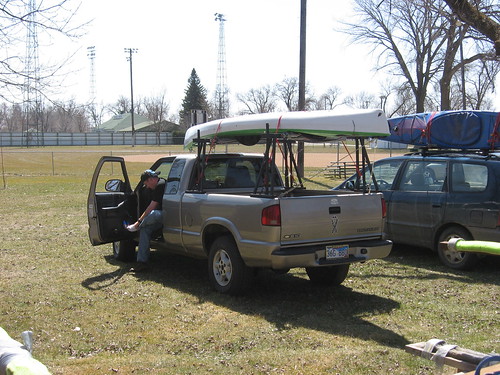
The older paddler has to be sure that he or she is capable of loading and hauling a boat appropriate for the intended purpose. My advice is to consider a solo canoe, a Kevlar kayak or canoe, or one of the lightweight plastic kayaks. At the same time, a manageable way to transport the boat has to be considered. The older paddler will have an increasingly tough time heaving a boat up onto the roof of a car, especially an SUV. I have heard of people who carry a little stepladder to use in securing the boat, but this gets a bit involved for the tastes of many older paddlers. The rollers and kayak cradle I use will work for many, a Folbot offers a good way to have a high quality boat and easy transport, and a trailer may be the easiest option of them all.
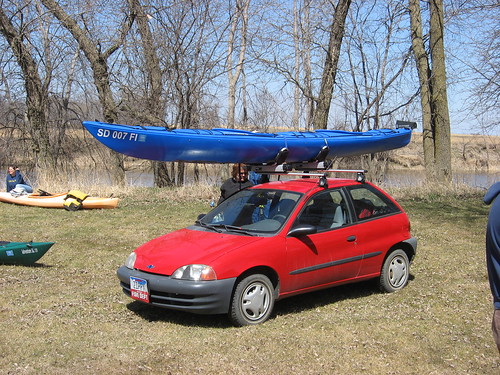

No comments:
Post a Comment